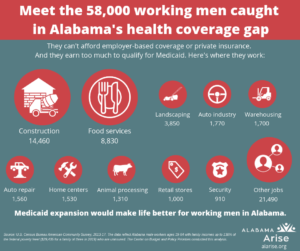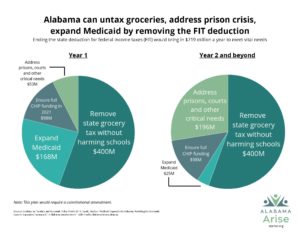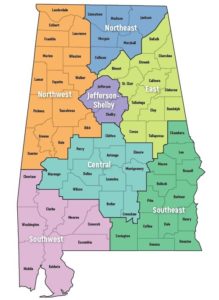Most people recognize the vital role that voting plays in a democracy – even if they don’t vote. But fewer understand the citizen’s role in lawmaking. Using your power as a constituent to influence legislators is called lobbying.
Alabama Arise promotes its interest – the well-being of Alabamians with low and moderate incomes – not by “wining and dining” lawmakers but by presenting well-researched policy analysis and lifting up the strong voices of Arise members who live in their districts. We hope you can use the information in this fact sheet to sharpen your skills as a citizen lobbyist.
How the legislative process works
Alabamians elect their state officers (Governor, Lieutenant Governor, etc.) and members of the Legislature every four years. These elections occur during the even-numbered years that don’t feature a presidential election. The Legislature’s four-year cycle is called a quadrennium.
The Alabama Legislature has two chambers:
- The Senate has 35 members (senators) from the 35 Senate districts. The presiding officer is the Lieutenant Governor. In his or her absence, the role is filled by the President Pro Tempore (president “for a time”) – called President Pro Tem for short – who is elected from the Senate by its members at the start of the quadrennium.
- The House of Representatives has 105 members (representatives) from the 105 House districts. The presiding officer is the Speaker of the House, elected from the chamber by its members at the start of each quadrennium. The Speaker Pro Tem presides in the Speaker’s absence.
Regular sessions and special sessions
The annual period when the Legislature meets is called the regular session.
- The regular session begins on the first Tuesday in March in the first year of a quadrennium. In the second and third years, it begins on the first Tuesday in February. And in the fourth and final year, it begins on the first Tuesday in January.
- The Legislature meets, usually on Tuesdays and Thursdays, for a maximum of 30 meeting days within a period of 105 calendar days. Committees most often meet on Wednesdays.
- The Governor may call a special session, indicating in a written “call” the subjects to be considered. No legislation on other subjects may be enacted during a special session without a two-thirds vote in both houses. A special session may last for up to 12 meeting days within a 30-day calendar span.
The Legislature’s main work is passing laws. Around 3,000 bills and resolutions are introduced each year. Some 40% of these are purely local in nature. About 180 to 200 general bills pass each year. Of these, only a small share affect the entire state. It often takes four years or more to pass a bill on a new subject.
How a bill becomes a law in Alabama
The process of proposing and passing laws is similar in the House and the Senate. Every new law must pass in both chambers.
- A member of either chamber introduces a bill, which is a proposed new law. Sometimes members introduce identical bills in both chambers at the same time.
- The bill gets a first reading (usually by title only) and is referred to a committee by the presiding officer.
- The committee considers the bill – in a public hearing, if the committee chairman receives a written request for one. A bill that wins committee approval is “reported out” to the full chamber in a second reading (usually by number only) and placed on the General Calendar for the next meeting day.
- On the next meeting day, the bill becomes eligible for its third reading and debate. The volume of bills, however, prevents most from being considered The Rules Committee places high-priority bills on the Special Order Calendar.
- The bill gets its third reading (by number only unless a member requests a full reading, usually as a delaying tactic) when its number comes up in the assigned sequence on the Special Order Calendar or General Calendar. Debate in the full chamber begins at this time. When debate ends, the members vote on the bill.
- After the bill passes one chamber, it goes to the other chamber and repeats the process.
- Once a bill passes both chambers, it goes to the Governor to be signed (approved) or vetoed (rejected).
- If vetoed, it goes back to the Legislature, where a simple majority vote can override (reverse) the veto.
- If the Governor signs the bill or the Legislature overrides a veto, the bill becomes an act, or law.
How you can influence the process
Before a bill is introduced:
- Stay informed about issues that are important to your group or community.
- Work with organizations that research issues and recommend policy changes.
- Talk to your legislators about introducing bills on issues important to your group or community.
- Write a letter to your local newspaper concerning issues that are important to your group or community.
When a bill is in committee:
- Contact committee members and ask them to support, reject or amend the bill – especially if your legislator serves on the committee.
- Ask others to contact committee members.
- Find out about and attend public hearings.
- Testify for or against the bill. Arise lines up people to show a range of support or opposition.
When the bill is being debated on the floor:
- Ask your legislators to support, reject or amend it.
- Ask family and friends to contact their legislators and request that they support, reject or amend the bill.
When a bill awaits the Governor’s signature:
- Call or write, urging the Governor to sign or veto.
- Ask family and friends to contact the Governor.
Make your influence more effective
Plan your call. Before contacting your legislators by phone, prepare an informal “script”:
- Give your name and where you live.
- Identify the general reason for your call – for example, “I’d like to talk with you about Medicaid.”
- Mention that you’re a member of Alabama Arise and that our members are interested in the issue. (To the legislator, this means voters!)
- Refer to a specific piece of pending legislation, if there is one, including the bill number.
- Make it personal. Tell a brief story or say why the issue matters to you.
- Ask them to vote for the bill and where. (Mentioning a particular committee or floor vote suggests you may even be there to watch!)
- Thank them in advance.
Try for direct contact
Legislators like to talk to voters. You can look up your lawmakers here, or get their contact information by calling 334-242-7600 (House) or 334-242-7800 (Senate). If you get a legislator’s secretary or answering machine, that’s OK! Your message still will get through. In this case, though, you must be even briefer: Leave out the story. No matter what kind of response you get, remain courteous. Anger doesn’t persuade.
Enlist other people to call with a similar message. Legislators know every phone call is the “tip of an iceberg.” For every person who takes the time to call, there are many others who share the caller’s concerns. Think of the number of voters you will represent if 10 or 20 people – or 50 or 100 – call on the same issue.
Take time to write a letter or email. Legislators do read their mail! Most legislators use email, and many are active on Facebook or Twitter as well. Keep your email subject line is simple and informative so it won’t resemble junk mail. You can write any legislator here: Alabama State House, Montgomery, AL 36130. Remember these tips:
- Use your own words. Form letters are easy to recognize and less effective than personal statements.
- Both handwritten and typed letters are fine.
- Include the same information you would cover in a phone call, as noted above.
- Limit your letter to one page in most cases.
- Put letter-writing on your group’s agenda. Keep paper, envelopes, pens, stamps and addresses handy.
As long as you’re writing, remember your local newspaper. A letter to the editor will put your issue in the minds of many people. Some may be inspired to write their own letters, supporting your points. Legislators regularly read opinions sections to find out what their constituents are thinking.
Get to know your legislators personally
Make your voice more “real” with a face and a handshake:
- Arrange a time to introduce your group as active constituents. Don’t wait until you have an issue to press.
- Make a point to speak to them whenever you see them in public – at ballgames, the grocery store, etc.
- Attend events where they are speaking.
- Wear a name tag to every meeting.
- Always tell them your name clearly and add a quick memory tag – for example, “My daughter goes to your child’s school,” or “I enjoyed your speech at the Kiwanis Club last Thursday.”
- Invite them to your meeting – but remember how busy they are during the legislative session!
- Help your group arrange a legislative reception.
- Visit the State House during the legislative session.
- Praise them when they deserve it, and respectfully express disapproval when they don’t.
For more information
Click here for an extensive, easy-to-use guide prepared by the Secretary of State. And please contact Alabama Arise at 334-832-9060 or info@alarise.org to learn more about speaking out and being heard on policies to make life better for Alabamians of all races, genders and incomes.







